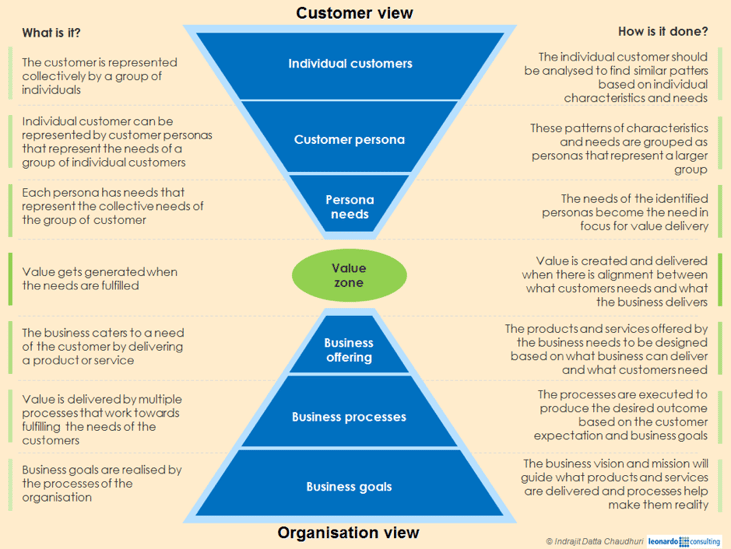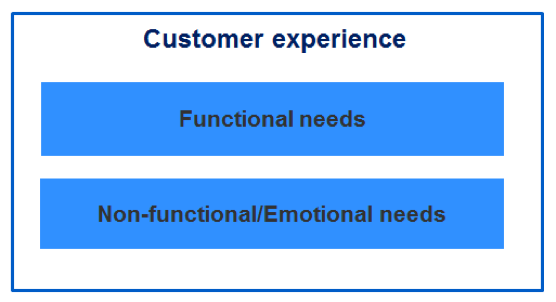
An organisation should be looking for ways to continually add value.At it's core Customer Experience Management understands what is of value for a customer, and how we create/deliver value, that will lead to actions that result in a good customer experience.
Value, in simple terms, is when the business offering meets the customer needs.
Defining ‘value’
Value is usefulness; value is utility; value is a problem solved. Value feels good.
Organisations constantly try to add value for their customers. In the past, there has been a siloed approach to adding this value. Each department put in an effort and attempted to give their best, only to find out that individual best does not necessarily lead to a holistic best, as sometimes the department’s direction is in conflict with others. A customer gets a good product and service when all the participants attempt to make the interaction value-added for the customer (not just the customer facing).
You may think that there is nothing new in this, and this is what people have always attempted. Every process-design effort undertaken in organisations has tried to achieve exactly that.
The key difference is that here we don’t need a stakeholder priority matrix to identify who to impress and who not to. The stakeholder is pre-identified—it’s the customer. The moment we say that every participant in the process is a customer, we are losing focus.
Here is where ‘product/service view’ comes into play. The following section is an attempt to reconcile the process and product/service views, and how that approach helps shift the focus from internal process participants to the customer.
Reconciling product/service, process and experience
Dr Michael Roseman, in his article Process management as service (2010), gave a very good description of process and service:
‘Process’ and ‘Service’ are complementary views on the same capability of an organization. As two distinct ‘sensitizing devices’, however, their associated viewpoints stress alternative facets of organizational capabilities. A process view sharpens the understanding for the operational model of a capability. It provides the required analytical foundation to reflect on the current and potential future performance of a capability as far as this performance can be impacted by the way it is delivered. As such, a process view can be seen as an approach to ‘white box a corporate capability’.
In contrast, a service-oriented (external) view on a corporate capability can be regarded as a ‘black box’ perspective. The emphasis is, as described above, on the conscious abstraction of the internal operations of this capability. Instead, the focus is on the overall value proposition (what can the service provide?), the related costs, the underlying governance model (‘what happens when the service fails, i.e., service continue management’), and further non-functional service properties as part of a service level agreement (response time, quality standards, etc.).
It is important to have a service (and/or product) view, because that is what the customer is ultimately consuming; the processes remain the mechanisms to deliver the service (and/or product).
For example: In a salon, the haircut is a service: take a ticket, wait, get a haircut and then pay for the haircut (make payment) is the process. The combination of a quick cut, easy payment and a nice hairstyling that gets you positive attention by your friends is good customer experience.
Product/Service is about benefits.
Process is about the mechanism to deliver a product/service. Experience is about the overall feeling that the customer has about the interaction.
Framework
Considering a customer as a single entity in a process design implies that all customers can be treated in exactly the same way. However, representing all customers in a similar manner oversimplifies and generalises the needs of the specific categories of customers. Customers with similar needs can be categorised together, and processes can be designed to cater for these different categories. These customer categories with similar needs can be called ‘persona’.
The following diagram depicts the perspective of aligning customer needs with the business offerings.

Figure 1: Value creation and delivery approach
This diagram has two sections. The top section is where an individual customer is considered from the point of view of his/her needs. Patterns are matched and customer personas are generated, and these represent a group of customers with similar needs. These needs of the various personas are the needs that, when satisfied, creates value.
The other perspective is the organisation view, where the business goals are delivered through execution of business processes. Business processes produce outcome; they deliver products and services while catering to the needs of the customers represented by the personas. The value zone represents the interface where needs are fulfilled, and the customer gets a good overall experience.
We are aligning what the business has to offer with what the customer needs. Needs that have two components: the stated needs, and the unstated needs. Good customer experience is the combined effect of fulfilling both needs.

Figure 2: Components of customer experience
To ensure the end user is in focus, we need to take a product/service view as well a process view. A product/service view ensures that the end-user needs are in focus, and a process view acknowledges that the outcome is a combined effect of multiple activities that span across the individual organisation entities.




